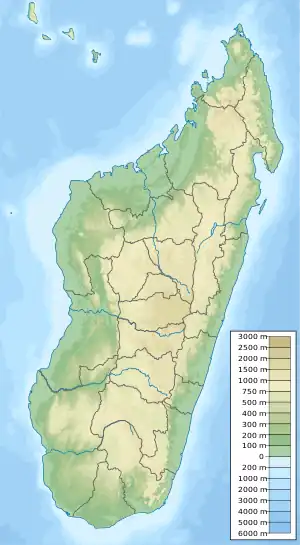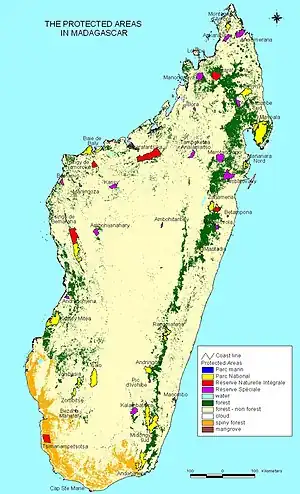| Andringitra National Park | |
|---|---|
 | |
 | |
| Location | Haute Matsiatra, Madagascar |
| Nearest city | Ambalavao |
| Coordinates | 22°6′46″S 46°55′23″E / 22.11278°S 46.92306°E |
| Area | 311.60 km2 (120.31 sq mi) |
| Established | 31 December 1927 (as nature reserve) 8 October 1999 (as national park) |
| Visitors | 3,436 (in 2011)[1] |
| Governing body | Madagascar National Parks Association (PNM-ANGAP) |
| Website | www |
| Official name | Parc National d'Andringitra |
| Part of | Rainforests of the Atsinanana |
| Criteria | Natural: (ix), (x) |
| Reference | 1257-012 |
| Inscription | 2007 (31st Session) |
| Endangered | 2010 |
| Area | 32,074.5 ha (79,258 acres) |
Andringitra National Park is a national park in the Haute Matsiatra region of Madagascar, 47 kilometres (29 mi) south of Ambalavao. The park was established in 1999 and is managed by the Madagascar National Parks Association. It was inscribed in the World Heritage Site in 2007 as part of the Rainforests of the Atsinanana.
History
The importance of the area was noted by explorers in the early 20th century and in 1927 the central part of the mountain range was declared a ″Strict Nature Reserve″. During the early 1990s the Malagasy Environmental Action Plan introduced the idea of Madagascar taking ownership of the environmental agenda, rather than donors, and in 1999 the area became a National Park.[2][3] In 2007 the park became part of the Rainforests of the Atsinanana World Heritage Site.[4]
Geography
The reserve covers 31,160 hectares (77,000 acres) covering much of the granite massif of the Andringitra mountains which rise above plains. The altitude of the reserve varies from 700 metres (2,300 ft) to the peak of the second highest mountain in the country, Imarivolanitra (formerly Pic Boby) at 2,658 metres (8,720 ft).[5] The mean annual rainfall is 1,500–2,500 millimetres (59–98 in) and snowfall occurs in some years. Madagascar's lowest temperature, −8 °C (18 °F) has been recorded here.[5][6] The Ampanasana, Iantara, Menarahaka and Zomandao rivers run through the reserve.
Three different groups of people live within the park. In the south and west the Bara people graze cattle on the savannah and in the valleys and on the ridges, while in the east the Bara Haronga grow rice, and the Betsileo people have developed an irrigation system on the mountain flanks of the north for rice cultivation.[5]
Flora and fauna
The park is one of the most biologically diverse places in Madagascar, with many endemic species. The eastern flank of the massif is covered with humid forest, and humid grassland and scrub in the higher areas. On the western flank there is relatively dry forest. There are over one thousand species of plants, one hundred species of birds, and fifty-five species of frogs are known to inhabit the park.[3]
There are over fifty species of mammals, including thirteen species of lemur. Andringitra's ring-tailed lemur population has notably thicker fur than the rest of the island's population. This is likely an adaptation to the colder climate at high altitudes.[7]
| Viewing time | Species |
|---|---|
| Daytime |
|
| Nighttime |
|
See also
References
- ↑ "Plus de 255.000 touristes à Madagascar en 2012". Linfo.re. Antenne Reunion Télévision. Retrieved 2023-02-24.
- ↑ Razafindralambo, Guy; Gaylord, Lisa. "Madagascar: National Environmental Action Plan". pp. 75–82. Retrieved 30 October 2016.
- 1 2 "Andringitra National Park". Travel Madagascar. Retrieved 30 October 2016.
- ↑ "Nomination of natural, mixed and cultural properties to the world heritage list – Rainforests of the Atsinanana". UNESCO World Heritage. Retrieved 30 October 2016.
- 1 2 3 "Andringitra National Park". Madagaskar.com. Archived from the original on 2016-07-02. Retrieved 30 October 2016.
- ↑ Preston-Mafham, Ken (1991). Madagascar: A Natural History. Oxford: Facts On File. pp. 211–2. ISBN 0-8160-2403-0.
- ↑ Mittermeier, R.A.; Louis, E.E.; Richardson, M.; Schwitzer, C.; et al. (2010). Lemurs of Madagascar. Illustrated by S.D. Nash (3rd ed.). Conservation International. p. 634. ISBN 978-1-934151-23-5. OCLC 670545286.
